The 1898 Pictorials Centenary marked a watershed in New Zealand philatelic history. The issue was amongst the first pictorial issues in the British Empire.
Issue information
New Zealand stamps had depicted portraits of Queen Victoria for 40 years. The decision not to include the monarch in this issue represented a first step to stamp New Zealand's emerging identity. It can be asserted that the 1898 Pictorials Centenary represented the world's first tourism promotion stamp issue.
The story started in 1894, when the New Zealand Government approved the issue of a new set of postage stamps that were to be 'symbolical of the land'. A call for entries in a competition, to decide the images, resulted in more than 2,400 submissions. A judging panel was appointed to make the final choices and, after some deliberation, the designs of H.W. Young of Auckland, J. Gaut and W.R. Bock of Wellington, E. Howard and E.T. Luke of Melbourne were selected. These designs then went on tour around the country.
The subjects covered by the five designers were diverse. They included Mount Cook, Lake Tekapo, Pembroke Peak in Milford Sound, the Huia (the now extinct native bird), Māori war canoes, Keas and Kākās, both the White and the Pink Terraces (destroyed in the Tarawera eruption of 1896), the Brown Kiwi, Lake Wakatipu (which was spelt incorrectly Lake Wakitipu, then corrected), the Otira Gorge and Milford Sound.
The stamps themselves went on sale on 5 April 1898, and immediately found favour with collectors. The recess process used to print them had yielded excellent results, and this, combined with the intricate scenic designs and use of bright colours (by contrast with previous issues), resulted in praise for the new issue. The lure of an 'error' stamp also did the issue's popularity no harm.
The decision to recreate New Zealand's first pictorial issue 100 years on (fourteen different stamps), was testimony to both the continuing popularity of this landmark issue and its philatelic significance.
Product Listing for 1898 Pictorials Centenary
| Image | Title | Description | Price |
|---|---|---|---|
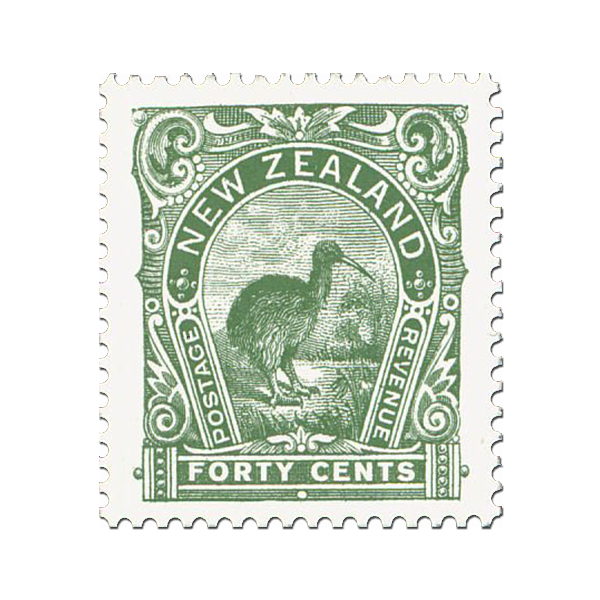 |
Single Stamp |
Single 40c 'Brown Kiwi' gummed stamp. The most ancient of New Zealand's birds, kiwi (Apterygidae) have been in the country since the Upper Cretaceous period, some 60 million years ago, and are the smallest member of the ratite group, which includes the cassowary, the emu and the now extinct moa. The name derives from the Māori description of the male's shrill and prolonged whistle, most often heard about an hour after dark. There are four species altogether, the little spotted kiwi (Apteryx oweni), the great spotted kiwi (Apteryx haasti) and two species of brown kiwi (Apteryx mantelli) and (Apteryx australis). They are unique to this country and they have become a national symbol. The kiwi is unable to fly and has no keel on the sternum (breast bone). The birds stand about 31 cm tall, and have a long, sensitive bill to find their food - worms, grubs and ground insects, and fruit fallen from trees to the forest floor. Once abundant in their homeland, kiwi numbers declined drastically since the arrival of European people and the subsequent clearing of vast tracts of land. |
$0.40 |
 |
Single Stamp |
Single 40c 'Fern trees with cabbage palms and Māori War Canoe' gummed stamp. The large single-hulled war canoe of Māori were up to 30 metres in length, nearly three metres wide, and carried up to 100 paddlers. They were unique in being the only single-hulled canoes in Polynesia. A relatively late development given the antiquity of Polynesian seafaring, they were made possible by the huge size of New Zealand trees. One writer in 1820 mentioned seeing a huge war canoe that was 25 metres in length, 1.8 metres wide and 1.5 metres deep, and hewn from a single log. Evidence suggests the canoe were used mainly for coastal warfare and were designed as much for show and prestige as for military or ocean-going functions. Painted red and black, they were fitted with elaborate head and stern ornamentation.. The stamp features a figure eight design with a crown and war canoe inside. Tree ferns are depicted on the left with cabbage palms on the right. |
$0.40 |
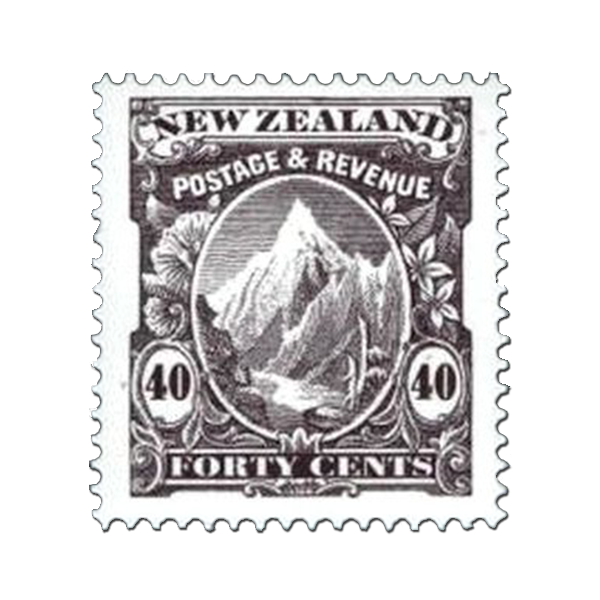 |
Single Stamp |
Single 40c 'Mount Cook' gummed stamp. At 3,754 metres,Mount Cook is New Zealand's highest mountain. It lies on the centre of the Mount Cook National Park, between the two largest glaciers in New Zealand - Hooker Glacier to the west and the Tasman Glacier to the east. Surrounded by no less than 16 peaks of more than 3,000 meters in height, Mount Cook is the culminating point of the Southern Alps. However geologies can offer no particular reason why the mountain should stand nearly 300 metres above its neighbours. Presumably, the height can be attributed to a rapid uplift caused by earthquake rather than to any special hardness and durability of the rock. The flowers depicted on the stamp are the ranunculus and celmisia - two varieties of alpine flora. |
$0.40 |
 |
Single Stamp |
Single 40c 'Lake Taupō' gummed stamp. Lake Taupō in the central North Island, is the largest inland stretch of water in New Zealand. Situated some 400 metres above sea level, the Lake extends to a maximum depth of some 170 metres. The Lake is renowned throughout the world for its fishing, and anglers come from far and wide to fight the famous Taupō rainbow trout. During the late 1920's, author and angler, Zane Grey, fought many a long and vigourous battle with these determined fish at the point where the Tongariro River enters the lake near Tūrangi. As a result his book Anglers' Eldorado, a publication heavily responsible for carving out the area's early reputation amongst the fishing fraternity, is largely centered here. Mount Ruapehu (2,797 metres) was illustrated in the background of the design, the tree to the left is a cabbage palm - named by early settlers who ate the head of the plant in place of cabbage. This was New Zealand's first two coloured stamp. |
$0.40 |
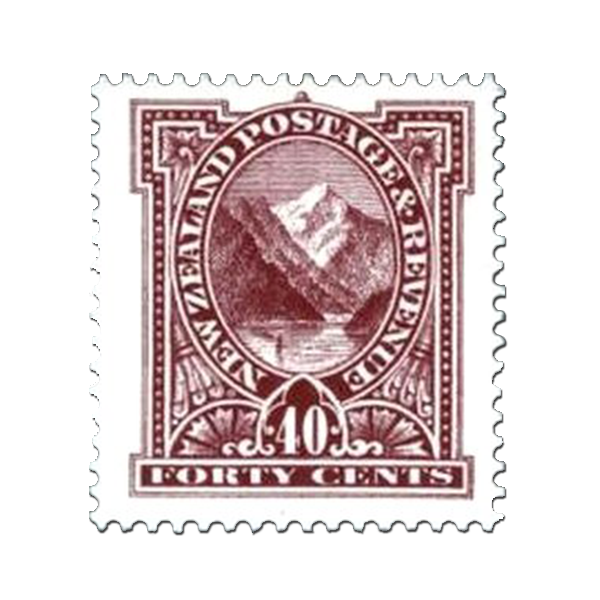 |
Single Stamp |
Single 40c 'Pembroke Peak, Milford Sound' gummed stamp. Pembroke Peak rises out of Milford Sound in the southern extremity of the west coast of the South Island to a height of 2,015m. The sounds of Fiordland are true fiords. The sea-filled remains of glacial action in an area that is among the oldest on the Earth's surface, there are 14 fiords in all. Milford Sound is a narrow canyon, 15 kilometres in length, 290 metres deep at its reach and 120 metres deep at the entrance. It is believed to have been named by John Grono, a sealing captain, when he made the first recorded visit there in 1809. Grono also named the Sound's Pembroke Peak, either after his home county or possibly Pembroke Castle. He went on to name various other landmarks in the area, including Bligh Sound, after his ship the Governor Bligh and Elizabeth Sound, after his wife. |
$0.40 |
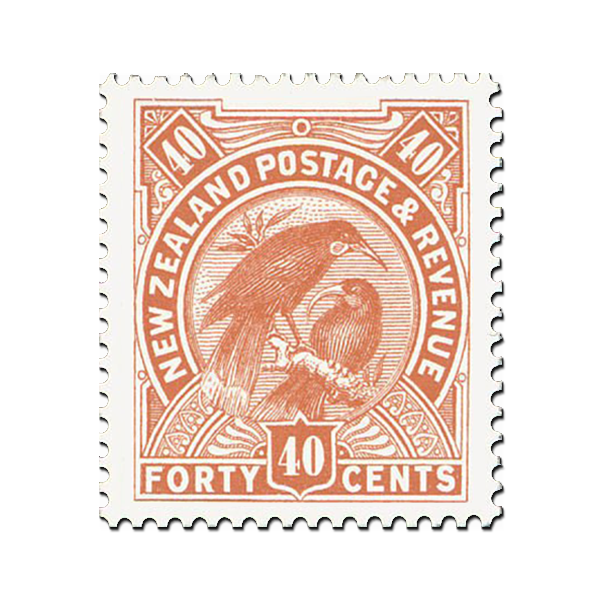 |
Single Stamp |
Single 40c 'Huias on branch' gummed stamp. The huia (Heteralocha acutirostris) was a medium sized slender bird, about the size of a magpie, with plummage that was generally black, though with a greenish gloss, and large beautiful orange wattles. It also had a distinct broad band of white across the tip of its tail feathers, which unfortunately proved to be its undoing. The huia belonged to the Callaeidae family, which includes the saddleback and the kōkako. It was the only bird in the world where the male and the female had different bills. Almost always seen in pairs, they normally bounded along the ground or from branch to branch, flying only when necessary. Huia tail feathers were greatly prized by Māori as symbols of rank and used as adornment by chiefs. The last official sighting of a huia was in 1907. However there were reported sightings as late as 1961, though these were never verified. This was as a result of hunting, clearing of their forest habitat and over-zealous specimen collecting for museums. |
$0.40 |
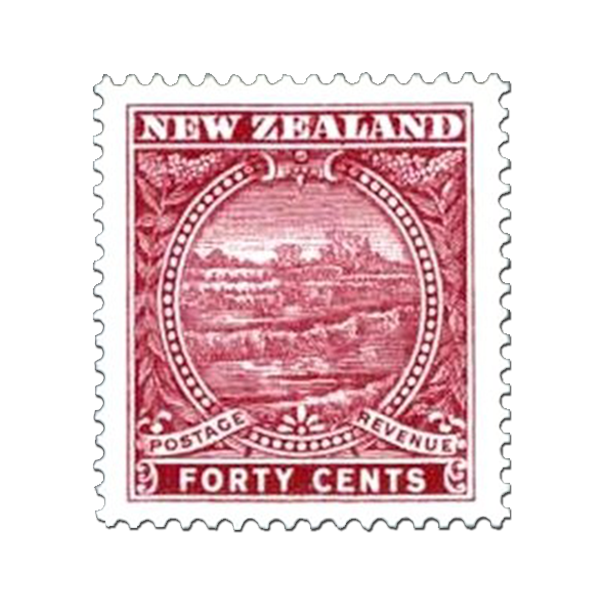 |
Single Stamp |
Single 40c 'White Terrace, Rotomahana' gummed stamp. Named Te Tarata by Māori, the White Terraces were shaped like a fan, 30 metres high, 240 metres wide, and covering an area of some three hectares. The terraces rose in a series of irregular steps to a small boiling crater lake. They were formed over thousands of years by a geyser, which had played over the mountain slope leaving deposits of silica. From a distance, the whole Terrace shone like silver alabaster, and, in bright sunlight, glittered with colours as varied as an opal. The water in the crater was azure blue, and it retained this colour as it flowed down into the various basins of the natural staircase. The White Terraces were a tourist attraction on the shores of Lake Rotomahana about 30 km from Rotorua. They were already world famous by 1886, when the eruption of nearby Mount Tarawera completely obliterated them. All that remains of this thermal wonderland are sketches, the paintings and the black and white photographs of those who visited. The plant depicted on the stamp is a native bramble, 'tātarāmoa'. |
$0.40 |
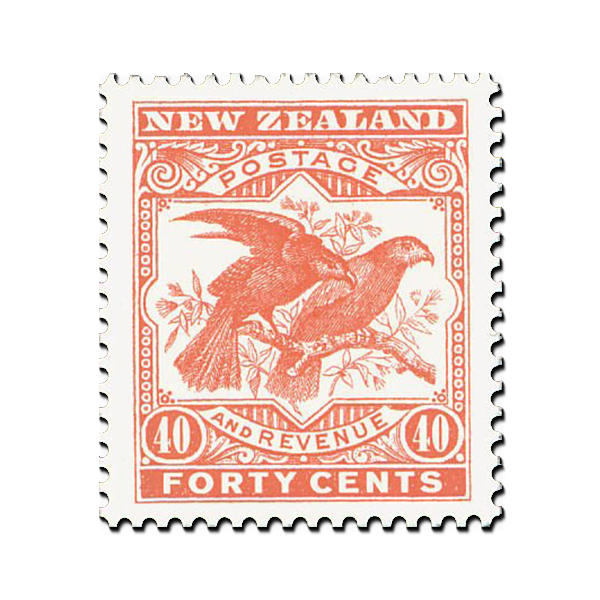 |
Single Stamp |
Single 40c 'Kea and Kākā on branch' gummed stamp. Kea and kākā both belong to the genus Nestor, a unique group of parrots now confined entirely to New Zealand. The kea (Nestor notabilis), closely resembles the kākā but is slightly larger and its elongated and slender bill is quite different from the distinctly curved arch of the kākā's upper mandible. This fearless bird featured on the left side of the stamp and is about 46 cm long with olive-green feathers and scarlet underwings. It is a bird of great personality, and is raucous and inquisitive. It can be found throughout the South Island and as far north as the Tararua ranges in the North Island, from sea level right up to an altitude of 2,000 metres. Kākā (Nestor meridionalis) and (Nestor septentrionalis), are largely limited to large tracts of native forest. Nocturnal by nature, the bird remains hidden during the hottest part of the day but its distinctive 'ka-ka' cry can be heard at night and can travelling some distance. The kākā is about 45 cm long, and its appearance is striking - bright red-orange neck, abdomen and rump, olive-green above, with scarlet underwings which can be seen when the bird is in flight. |
$0.40 |
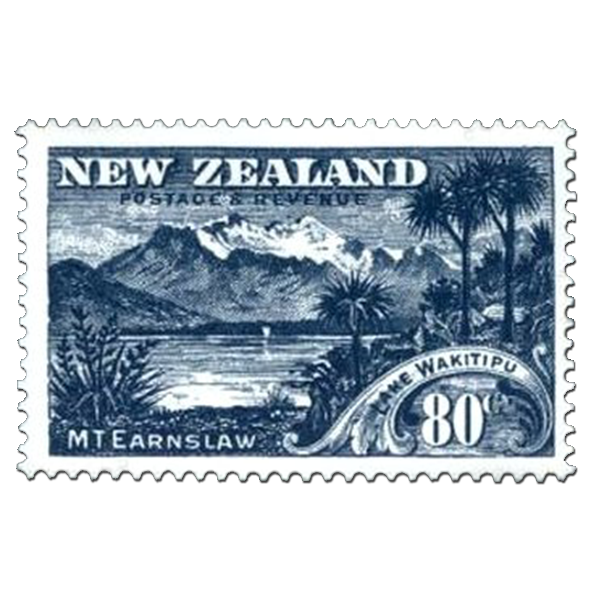 |
Single Stamp |
Single 80c 'Mount Earnslaw, Lake Wakitipu' gummed stamp. New Zealand's best known stamp error - the name of the lake was mis-spelt. It caused considerable interest when issued and further printings were made to satisfy the purely philatelic and speculative demand. The consequence was that in its mint form, the error is more common than the correct spelling (Wakatipu). Most of those who bought the stamp retained them unused and genuinely used copies are not common. Wakatipu is the second largest lake in the South Island, after lake Te Anau, and covers 293 square km |
$0.80 |
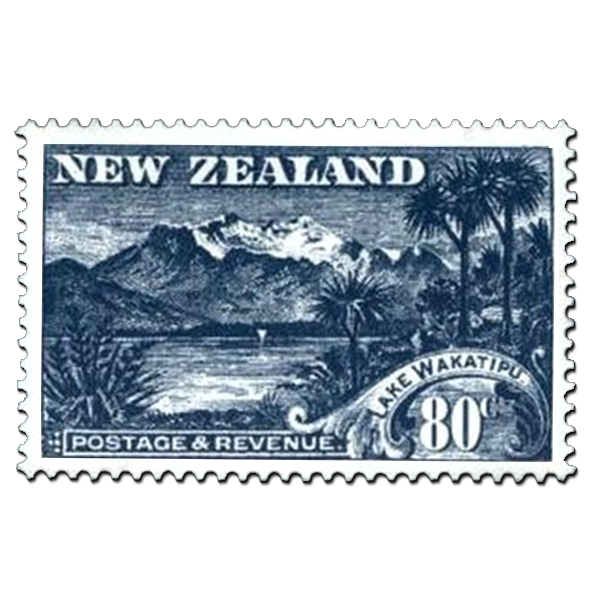 |
Single Stamp |
Single 80c 'Mt Earnslaw, Lake Wakatipu' gummed stamp. Lake Wakatipu lies at the southern end of the Southern Alps in Central Otago. Long narrow and extremely deep it occupies a single glacial trench and is bordered on all sides by mountains. The name Wakatipu is said to be a shortened form of Wakatipua - waka meaning trough and tipua meaning goblin. In ths interpretation the trough is the lake and the goblin (or monster) lies underneath, and it is his breathing that causes the water within the trough to rise and fall regularly. On the stamp Mount Earnslaw (at over 2,400 metres) is depicted in the background of the design, also illustrated at the left, is New Zealand flax, and at the right, cabbage palms and toi toi. The original version of this stamp was issued to replace the Lake Wakitipu spelling 'error' stamp. |
$0.80 |
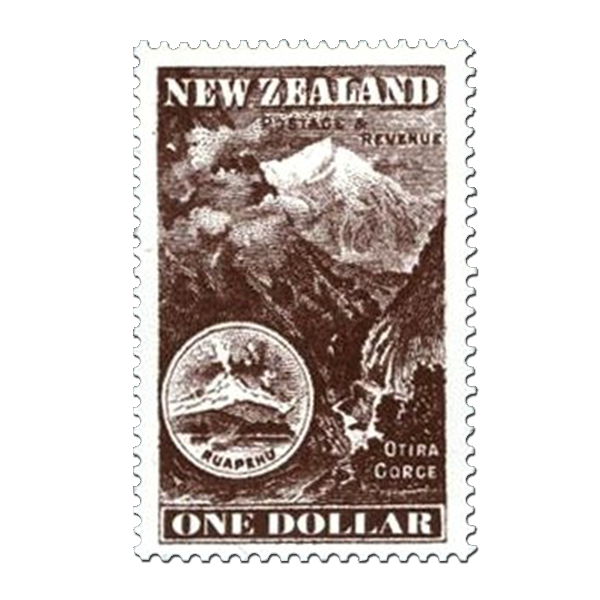 |
Single Stamp |
Single $1.00 'Ruapehu/Otira Gorge' gummed stamp. The Otira gorge is a deep and narrow gorge cut in the mountains on the main route across the Southern Alps. A railway across the Southern Alps was first propsed in 1862. However, the first sod to start the section across the mountains was not turned until 1887. To those present, it must have seemed that finally, the transalpine railway would soon be a reality. They were to be sadly mistaken. Rotten rock, crumbling shale and deluges of water into the tunnel that had to be cut through the mountains slowed progress considerably. The lining of the tunnel was finally completed in 1921, and on 4 August 1923 the Prime Minister, William Massey, opened what was, at the time, the seventh longest tunnel in the world. Also inset within the design of the stamp is Mount Ruapehu (2,797 metres). |
$1.00 |
 |
Single Stamp |
Single $1.20 'Pink Terrace, Rotomahana' gummed stamp. The Pink Terraces called Otukapuarangi by Māori or 'fountain of the clouded sky' were some 1.5 kilometres from the White Terraces on the western side of Lake Rotomahana. They were famous for their bathing, and every year hundreds came from around the world to luxuriate in basins that were up to 1.5 metres deep and filled with clear blue water warmed to between 32 degrees celsius and 50 degrees celsius. Mount Tarawera erupted on the night of 10 June 1886 and destroyed the terraces forever. So huge were the eruptions that the Assistant Surveyor-General S. Percy Smith, later calculated the inferno had affected 4,800 square kilometres of land. An estimated 153 people were killed in the sparsely populated area, and three Māori villages were destroyed. The only records of these scenic phenomena are paintings and photographs taken by some of the thousands of people who went there as tourists. Also featured on the stamp were a tree fern on the left of the design and nikau palm at right. |
$1.20 |
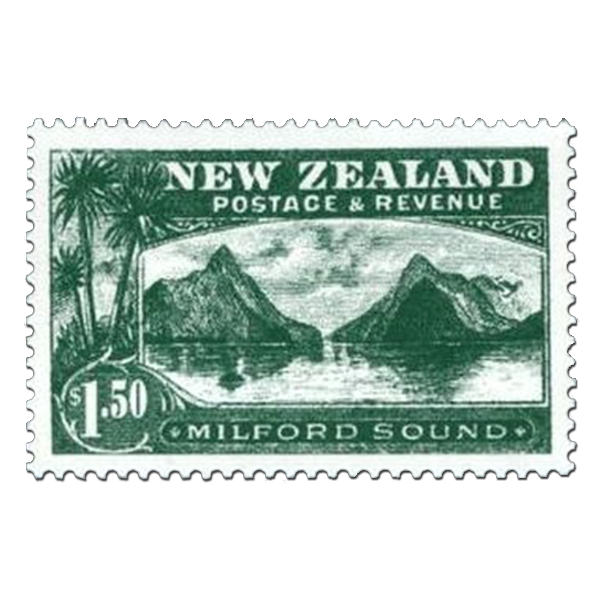 |
Single Stamp |
Single $1.50 'Milford Sound' gummed stamp. Milford Sound is the most majestic of the fiords of Fiordland, with sheer rock faces soarng 1,200 metres steeply form the sea, backed by mountains as high as 1,900 metres. The Milford Track lies between the Milford Sound and Lake Te Anau. Opened in 1888, this 54 kilometre walk is hailed as one of the greatest tramping tracks in the world. One of the most famous features of the Track is the Sutherland Falls. Named after Donald Sutherland, the first European to sight them in 1880, the Falls are around 580 metres high. This makes them easily the tallest waterfall in New Zealand, and amongst the highest in the world. This region of the South Island has some of the most majestic, unspoilt scenery in the world. Milford is the northernmost of a number of fiords that cut deeply into the coastline, and it is the most spectacular with sheer rock faces soaring 1,200 metres steeply from the sea, backed by mountains as high as 1,900 metres. Mitre Peak (1,695 metres) is depicted on the right of the stamp and cabbage palms at the left. |
$1.50 |
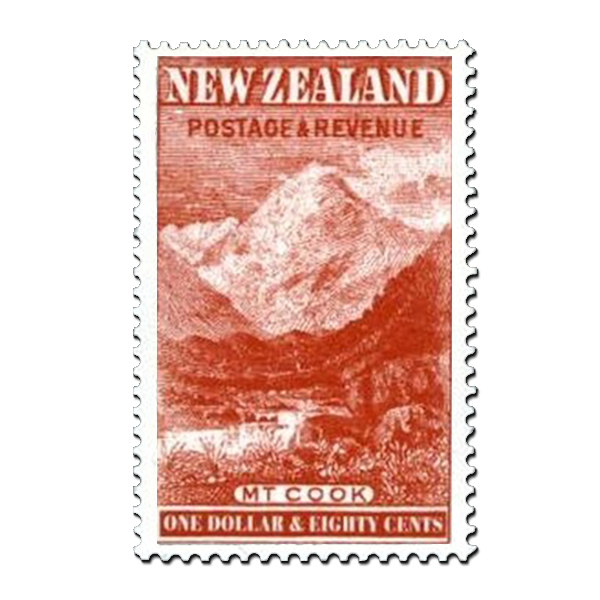 |
Single Stamp |
Single $1.80 'Mount Cook' gummed stamp. Mount Cook New Zealand's highest mountain, is over 3,700 metres in height, and is situated in the South Island's Southern Alps. It was first climbed by three New Zealanders Fyfe, Clark and Graham on Christmas day in 1894. The first woman to climb the mighty peak was Australian Freda du Faur, in December 1910. In January 1913, du Faur went even further, becmoing the first woman to make the Grand Traverse, crossing from the Hooker Valley to the Tasman Valley via the entire summit ridge of the mountain. Mount Cook remains one of the great New Zealand mountaineering challenges, with around 200 people a year from all over the world making attempts to conquer the peak. In 1997 as part of the Ngāi Tahu land settlement, the mountain was officially renamed Aoraki Mount Cook.
|
$1.80 |
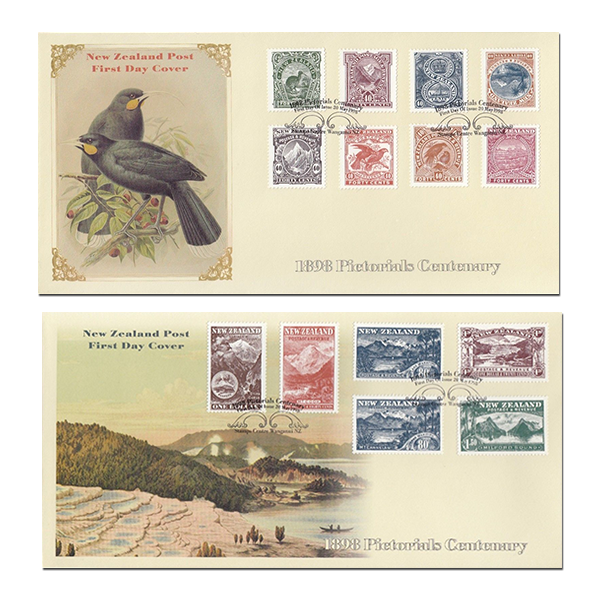 |
Set of First Day Covers | Set of two first day covers with stamps affixed. Cancelled on the first day of issue. | $11.30 |
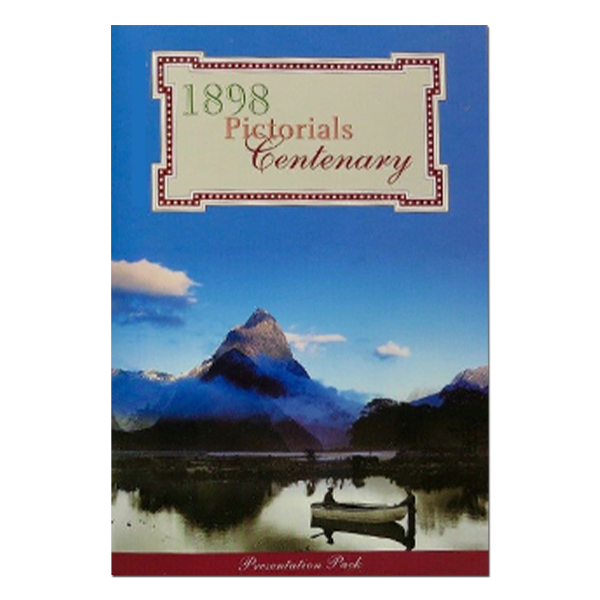 |
Presentation Pack | Presentation pack containing a selection of stamp products from the issue and further information on the theme of the stamps. | $12.50 |
Technical information
| Date of issue: | 20 May 1998 |
|---|---|
| Number of stamps: | 14 |
| Denominations and designs: | 40c Brown Kiwi; 40c "8" with fern trees, cabbage palms and Māori war canoe; 40c Mount Cook; 40c Lake Taupō; 40c Pembroke Peak, Milford Sound; 40c Huias on branch; 40c White Terrace, Rotomahana; 40c Kea and Kākā on branch; 80c Mount Earnslaw, Lake Wakitipu; 80c Mt Earnslaw, Lake Wakatipu; $1.00 Ruapehu/Otira Gorge; $1.20 Pink Terrace, Rotomahana; $1.50 Milford Sound; $1.80 Mount Cook |
| Stamps redesigned by: | Ross Jones of Watermark, Wellington, New Zealand |
| First day covers designed by: | Ross Jones, Wellington |
| Printer and process: | Southern Colour Print, New Zealand by lithography |
| Number of colours: | 40c Lake Taupo: 2 PMS colours; all others 1 PMS colour |
| Stamp size and format: | 40c stamps: 22.8mm x 25mm (vertical); 80c, $1.20, $1.50 stamps: 36mm x 23.43 (horizontal); $1.00, $1.80 stamps: 23.43mm x 36mm (vertical) |
| Miniature sheet size: | 90mm x 80mm |
| Paper type: | 104gsm red phosphor coated litho stamp paper |
| Number of stamps per sheet: | 25 |
| Perforation gauge: | 14 |
| Cost of unadressed first day cover with eight 40c stamps: | $3.70 |
| Cost of unadressed first day cover with six stamps of mixed denominations: | $7.60 |
| Special blocks: | Plate/imprint, positional or value blocks could be obtained by purchasing at least six stamps. Colour blocks ('traffic lights') were included in plate blocks. Barcode blocks were available only in B format. |
| Period of sale: | These stamps remained on sale until 20 May 1999. |


